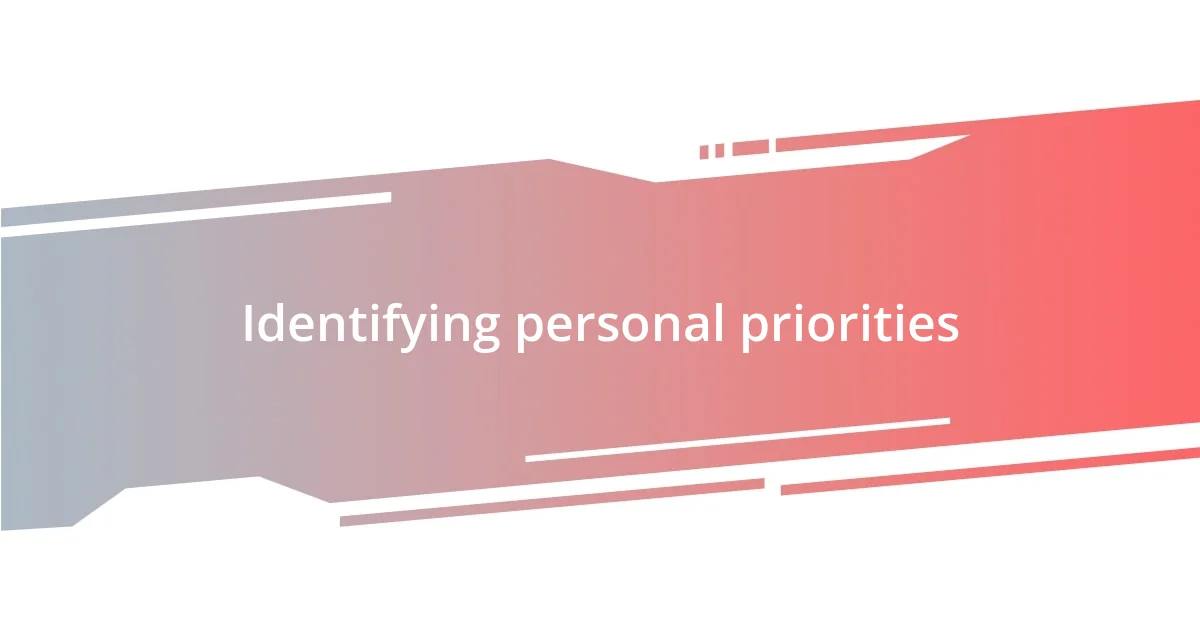Key takeaways:
- Balancing treatment and life requires embracing both emotional struggles and supportive relationships, which help in coping with challenges.
- Establishing personal priorities, such as health, family, and self-care, provides clarity and direction in making decisions related to treatment.
- Seeking professional guidance from therapists and nutritionists can significantly enhance emotional resilience and overall well-being during treatment.

Understanding life and treatment
Understanding life and treatment requires a deep recognition that both aspects are intertwined. I often find myself reflecting on the moments where treatment felt overwhelming but the support from my family turned those days around. It makes me wonder: how do others find strength in their loved ones during challenging times?
There was a day when I juggled a hectic schedule, balancing a crucial treatment and a work deadline. I remember sitting in the waiting room, staring at the wall, thinking about how these experiences shape my outlook on life. It was in that moment that I realized the importance of viewing treatment not just as a medical process, but as a part of my life’s journey.
I’ve learned that understanding life alongside treatment means recognizing the emotional rollercoaster it brings. Have you ever felt like you were on a seesaw, constantly adjusting to the ups and downs? Embracing both the good and the tough moments has helped me find a rhythm, allowing me to appreciate the beauty that life still holds, even amidst challenges.

Identifying personal priorities
Identifying my personal priorities has been a game changer in navigating both life and treatment. I vividly remember a time when I had to choose between attending a family gathering or sticking to my treatment schedule. After some reflection, I decided to prioritize that gathering, not only because it would lift my spirits but also because it reinforced my connections. It made me realize that nurturing relationships often helps me cope better with treatment.
When it comes to recognizing what truly matters to me, I focus on a few key areas:
- Health: My treatment and well-being are at the forefront of my priorities.
- Family: Spending quality time with loved ones brings me joy and comfort.
- Work: I strive to maintain a balance between my professional responsibilities and my health needs.
- Self-care: Taking time to recharge mentally and physically is essential for my overall resilience.
By listing these priorities, I’ve found clarity in my decisions, allowing me to navigate challenges more smoothly. Balancing life and treatment isn’t just about managing schedules; it’s about making conscious choices that resonate with my values.

Creating a supportive environment
Creating a supportive environment has been crucial in balancing life and treatment. I recall a time when I felt isolated during my treatment journey; it was a dark place for me. That changed when I decided to reach out to friends and family. Organizing small gatherings, like movie nights or dinner, transformed my outlook. These moments made me feel valued and connected, reminding me that I wasn’t alone. Surrounding myself with supportive individuals truly uplifted my spirits, and I recommend it to anyone fighting similar battles.
It’s interesting how a supportive environment can come from unexpected places. I’ve found that even online communities can provide a sense of camaraderie. For instance, I joined a support group where we shared our experiences. The understanding and encouragement from others who knew what I was going through felt like a warm hug. We didn’t just talk about treatment—we also shared jokes and life stories. This balance of seriousness and light-heartedness created a safe space for sharing our struggles and victories.
Creating the right ambiance at home has also been vital. I remember altering my living space by decluttering and adding cozy elements, like soft lighting and comfortable blankets. This change turned my home into a sanctuary, a place where I could relax despite the challenges I faced. When my environment feels peaceful and inviting, it positively affects my mental state, making it easier to tackle both life and treatment in harmony.
| Supportive Elements | Personal Experience |
|---|---|
| Family gatherings | Strengthened my connections and boosted my mood |
| Online support groups | Provided camaraderie and valuable insights from shared experiences |
| Comfortable home ambiance | Created a relaxing sanctuary that eased my emotional stress |

Establishing a daily routine
Establishing a daily routine has been transformative for me. I remember when treatment felt overwhelming, and I had no structure; it was chaos. So, I started creating a simple daily schedule, incorporating my treatment times, meals, rest, and even moments of joy — like a walk in the park or reading my favorite book. This structure not only keeps me on track but also gives me a sense of accomplishment at the end of each day.
In my experience, the key is to find a rhythm that suits your needs. For instance, I’ve learned that mornings are my most productive times, so I tackle my most challenging tasks then. But I also build in flexibility. On days when I feel fatigued, I allow myself to adjust my routine without guilt. I ask myself, “What do I need today?” This question often leads me to prioritize rest or light activities on those tougher days.
I also find it essential to include rituals in my daily routine that ground me. For example, I’ve integrated a gratitude journal into my evenings. Before bed, I reflect on three things I’m thankful for, and it shifts my mindset positively. This practice provides closure to my day, calming my mind for better sleep. It’s incredible how such small habits can make a big difference, isn’t it? Establishing a routine isn’t just about managing time; it’s about creating a life that feels balanced and fulfilling.

Managing stress and self-care
Managing stress and self-care is a delicate dance, and I’ve found that little moments of self-compassion can be game-changers. I remember a particularly stressful week during treatment when everything just felt too heavy. To cope, I began treating myself to a simple ritual: a warm bath infused with calming lavender. In those moments, I would breathe deeply, letting go of the tension in my shoulders. It’s amazing how something so simple can shift your entire perspective, isn’t it?
On days when stress feels all-consuming, I’ve leaned into mindfulness practices like meditation or quick breathing exercises. I vividly recall sitting in my garden, eyes closed, focusing on the gentle rustle of the leaves and the warmth of the sun. Those few minutes of intentional stillness transformed my mindset, allowing me to approach challenges with renewed clarity. Have you ever felt how powerful nature can be in grounding you? For me, those experiences became essential tools for maintaining my calm.
I can’t overlook the power of physical activity in managing stress. There were days when I didn’t feel like doing much at all, but a brisk walk around my neighborhood opened up my mind and heart in a way I didn’t expect. I could feel the endorphins flooding in as I let myself get lost in my favorite podcast. Each step felt like a release of pent-up energy, reminding me that I have agency in my life—even amid treatment. So, when life feels overwhelming, I ask myself, “What small action can I take right now?” And often, that leads me to profound places.

Utilizing coping strategies
Utilizing coping strategies really opened my eyes to the importance of emotional resilience during treatment. I remember a particularly challenging phase when I felt completely lost. I decided to give journaling a go, and honestly, it transformed my state of mind. Each evening, I’d pour out my thoughts onto the page, letting my emotions spill out without judgment. How cathartic is it to give your feelings a voice? It’s a small but profound way to process what I was going through, allowing me to see my struggles in a new light.
One coping strategy that surprised me with its effectiveness is connecting with others who understand my journey. I found a local support group, and the first time I attended, I almost didn’t go. But sitting in a circle of shared experiences, I felt seen and understood. I realized how much lighter my burden became when I shared my story and heard theirs. Have you ever considered how powerful it is to connect with someone who gets it? Those conversations became a lifeline, reminding me that I wasn’t alone in facing the ups and downs.
I also leaned heavily on creative outlets as a coping strategy. I remember during a particularly grueling day, I picked up my paintbrush and let my emotions flow onto the canvas. As colors swirled and shapes emerged, I felt a weight lift off my shoulders. It’s fascinating how expressing ourselves creatively can be healing, isn’t it? Whether it’s writing, painting, or playing an instrument, these activities provide an escape and a way to channel complex feelings into something tangible, enriching my healing journey in unexpected ways.

Seeking professional guidance
Seeking professional guidance has been a cornerstone of my journey. Early on, I hesitated to reach out, thinking I could manage everything on my own. But the moment I decided to consult a therapist, it was like lifting the fog. I vividly remember my first session—it was intimidating, yet so liberating to share my struggles with someone trained to help. Have you ever felt that rush of relief that comes from simply being heard?
Throughout my treatment, having a professional to turn to made a world of difference. I recall one particular day when everything felt overwhelming, and my therapist encouraged me to explore my fears surrounding treatment. Through that discussion, I gained insight into my anxiety, transforming an emotion that had gripped me into a manageable part of my experience. It’s intriguing how those conversations can build bridges to self-awareness, isn’t it?
Additionally, I found that engaging with a nutritionist enhanced my overall wellbeing. I was unsure how my diet impacted my treatment, but after a few sessions, I started to recognize the connection. One afternoon, we crafted a meal plan together, focusing on foods that nourished not just my body but my mind as well. The positive changes I experienced were not just physical; they infused my spirit with vitality. Have you ever noticed how the right food can uplift your mood? I certainly did, and it made seeking that guidance all the more worthwhile.















